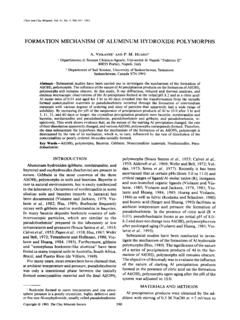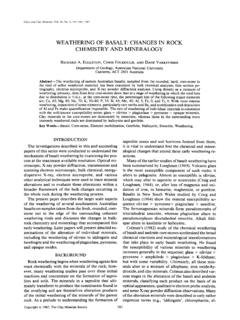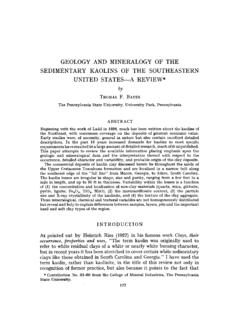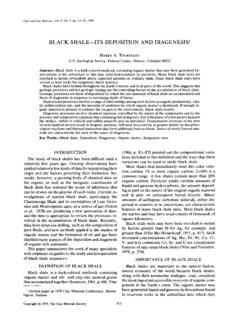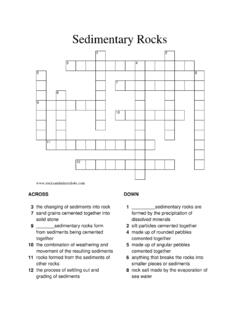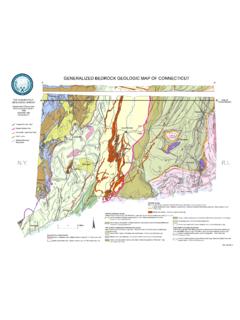Transcription of BULK DENSITIES OF SELECTED DRIED NATURAL …
1 Clay.~ and Clay Minerals, Vol. 23. pp. 424-427. Pergamon Press 1975. Printed in Great Britain bulk DENSITIES OF SELECTED DRIED NATURAL AND FIRED KAOLIN CLAYS DAVID BAUMANN and W. D. KELLER Department of Geology, University of Missouri-Columbia Columbia, MO 65201 (Received 7 July 1975; and in finaljbrm 12 October 1975) Abstract-- bulk (lump) DENSITIES of 31 kaolins were measured on the clay in the NATURAL or raw state after drying at 100~ and after firing to 1510~ (2700~ The kaolins were SELECTED from such diverse origins as surface-weathered and sedimentary accumulations, hydrothermally altered bodies and flint- clay deposits.)
2 The sedimentary group ranged in density from to 1-85 in the DRIED raw clay, and to 2-63 when fired. The hydrothermally altered clays ranged from to in the DRIED raw state, and to when fired. Flint clays ranged from to in the DRIED raw state (a "toasted clay" from Russia, ), and to when fired. The effect of the genetic process on bulk density values is discussed and related. INTRODUCI'ION bulk density, the density measured on a small or hand-specimen size fragment, is an important pro- perty of rocks. It is a direct measurement that reflects the density of the constituent minerals or materials plus the included open pores.
3 Indirectly, it may yield significant information on the environment under which the rock originated and on the packing, cemen- tation, or crystallization of its components. Kaolins (defined as rocks which are characterized by a signifi- cant content of kaolin minerals) may vary widely in bulk density with their , whether in situ surface-weathered products, sedimentary clays, hydro- thermally altered within or under a heavy, tight rock cover, or as sedimentary deposits comprised of flint clays. The bulk density of clay (kaolin) commonly plays also an important role in its economic value when fired (as a refractory, filler, coater, absorbent, etc.)
4 High-density is commonly desired, or demanded for clay refractories because high fired-density usually confers high physical strength at high service tem- peratures and high resistance to service corrosion, slag penetration, and abrasion. High-density clays in the NATURAL , lump state which also are high in (Pyrometric Cone Equivalent, a measurement of fusion) typically yield refractory material in the high- density range, but not necessarily so. During the firing process, clays flux over a wide range in temperature, wherein the most active fluxing begins at loci of alkali and alkaline-earth elements.
5 As the clay particles flux, their surfaces become wet, whereby they cohere with adjacent particles, shrink- ing the mass and reducing its porosity. Depending upon the composition of the clay, a higher rise in temperature eventually will overfire the clay, develop- ing many initially microscopic, gas-filled, closed pores. These pores may enlarge upon further heating, due to expansion of the gas and melting of clay, thereby greatly expalMing the mass and decreasing the bulk density. Such porous fired material may be useful for insulation and light-weight adaptations.
6 Literature on the bulk DENSITIES of kaolins is not abundant and is typically appended to other observa- tions on clays. Klinefelter et al. (1943) however, reported that the dry bulk specific gravities of Geor- gia kaolins ran from to in soft kaolins, 1-57 to in semi-hard varieties, to 1-79 for hard, and one sample of very hard kaolin ran Patter- son and Hostermann (1962), published bulk DENSITIES on 38 samples of refractory clay from the Olive Hill District of Kentucky. These air- DRIED clays ranged from 2-10 to 2-52 in bulk density, 11 being in the group, and 21 from to inclusive.
7 When heated to 1400~ bulk DENSITIES ranged from 1 at 1-06, to 1 at , with the modal group (12) in Some samples exhibited overfiring at 1600~ LABORATORY MEASUREMENTS Thirty-one kaolins from diverse origins and locali- ties were SELECTED for study. Single fragments of kao- lin, ranging in weight from about 5-25 g, were broken from field samples and DRIED at 100~ These were thinly coated with melted paraffin (to prevent pene- tration by water), reweighed to correct for the volume of paraffin and their volumes measured in a volu- meter displacing water. After the DRIED NATURAL (raw) clays were measured, the samples were fired in individual crucibles in a large industrial laboratory test furnace to 2750~ (1510~ and soaked at that temperature for hr.)
8 The heating schedule generally used for measuring fired- DENSITIES was followed, although our samples were larger (adopted to geologic samples of raw clays) than in the industrial procedure. Density results are listed in Table 1. 424 bulk DENSITIES of SELECTED DRIED NATURAL and fired kaolin clays 425 DISCUSSION bulk DENSITIES of DRIED NATURAL , unfired kaolins The bulk DENSITIES of kaolins in the DRIED NATURAL (raw, or unfired) state reflect their mode of genesis. Those which originated as surficial weathered deposits, or as deposits of either sedimentary kaolin or water-laid materials which were later kaolinized, possess relatively low bulk DENSITIES .
9 All are under , the highest found in this study was 1-85, in endellite from Gardner Ridge, Indiana. This clay is actually not a clastic kaolin and perhaps should be placed in a separate category. The lowest density, , is of endellite (4) collected from a "concretion- ary" deposit (definitely non-clastic) currently nee- forming within a residual, Paleozoic paleosol, over Silurian Brassfield limestone. It was solution-soaked and very soft when dug out of the bed cropping out in a road cut. Very high porosity was developed upon drying, Note that Georgia (2, 14, 16), Murfreesboro, Arkansas (10), and Jacal, Mexico (17) sedimentary kaolins, and North Carolina "primary kaolins" (hal- loysite) (3, 6) possess low bulk DENSITIES .
10 Near-surface kaolinization of these clays with relatively little over- burden generated high porosity and low bulk density, a mean value 1-45 for 11 samples. This order of mag- nitude is believed to be genetically significant for sedi- mentary kaolins. Hydrothermally formed kaolins (all fl'om Mexico) have distinctively higher bulk DENSITIES . Four of them which were altered from lava, schist, or a calcareous sandstone (1, 18, 11, 19) run over 2'0, a mean of 2'36. No. 15 is a vein deposit, hence more like No. 4 in Table 1. A. Surface-Weathered and Sedimentary Kaolins NATURAL -Raw e Fired (1510~ ( DRIED at II0 C) Sample Number Clay Density Clay Density 2 3 4 5 6 I0 12 13 14 16 17.)





